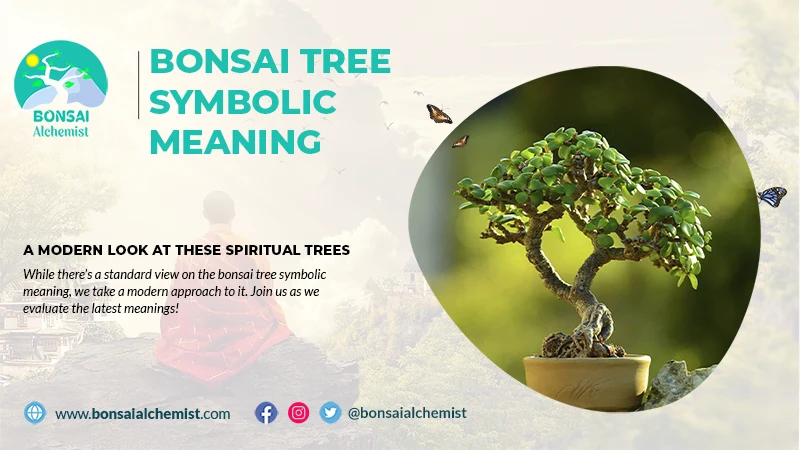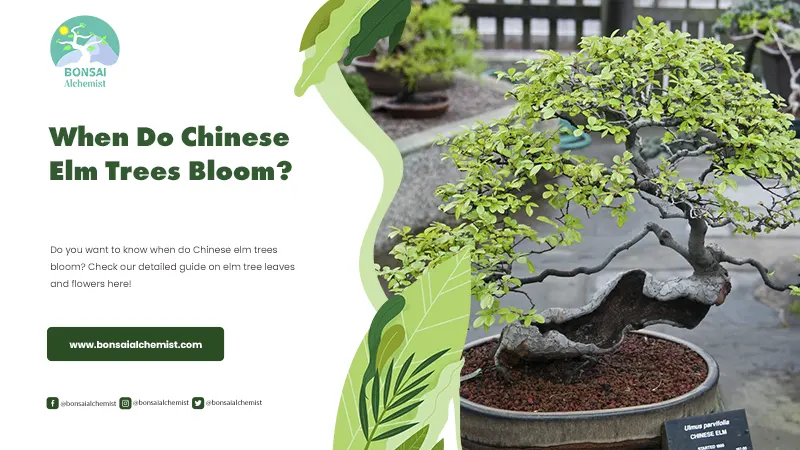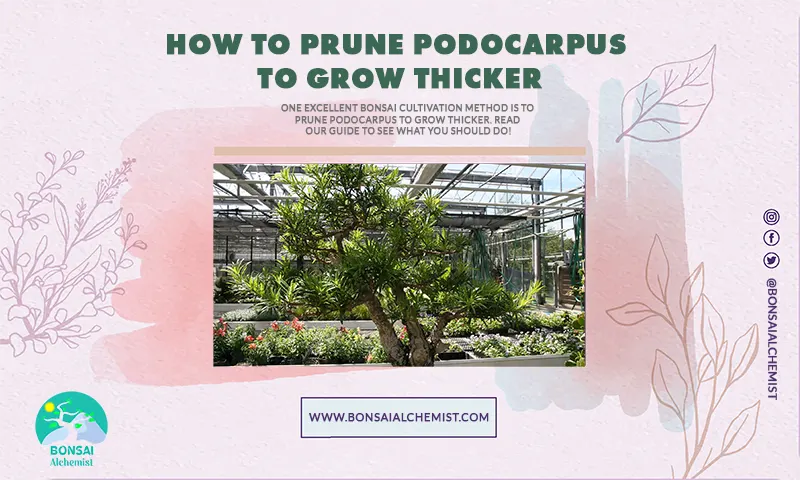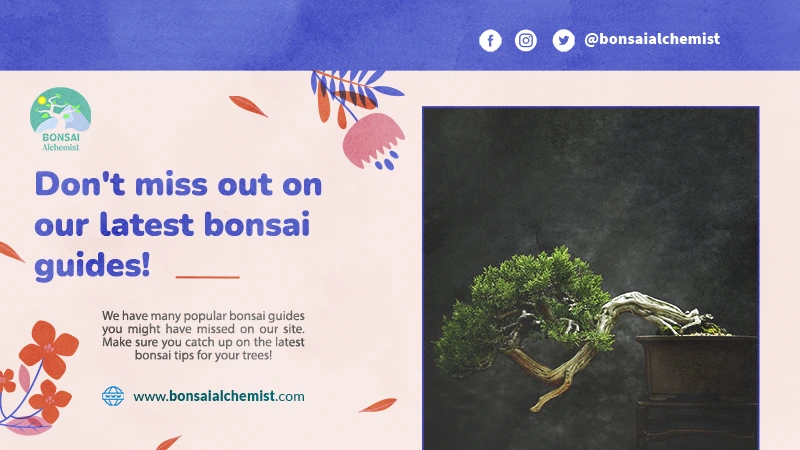Pomegranate Bonsai
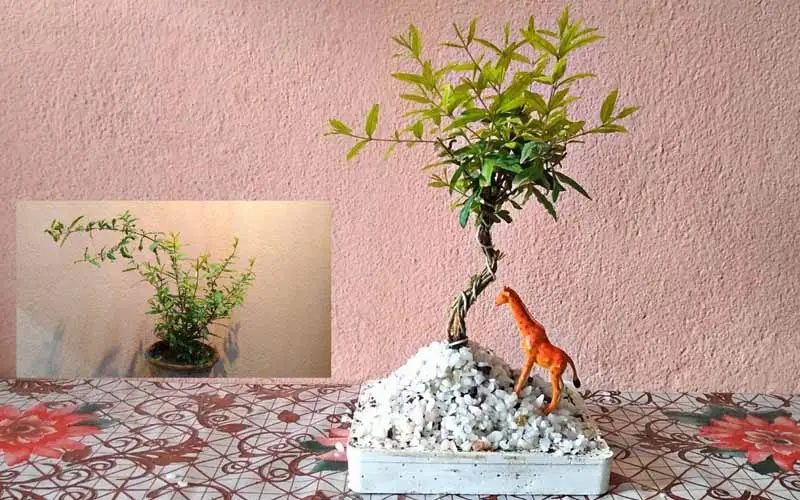
The pomegranate tree, which is also known as Punica Granatum, makes a very popular bonsai. Bonsai enthusiasts love this sturdy tree for its drought resistance and tolerance to cooler temperatures. Not only that, but the pomegranate is also a flowering and fruit-bearing tree, which is a real treat to work with. The trunk of pomegranate trees also has a natural twist, making it an amazing bonsai.
Table of Contents
Quick Pomegranate Bonsai Care Sheet
As a quick reference, we have summarised the information of this care sheet in this handy table which is easy to refer back to. We will be covering this information in more detail in the sections that follow.
Recommended soil
Pomegranate bonsai do especially well in soil with a high lime and sand content that drains well.
Watering
Summer: Daily, the soil must be kept moist. Winter: Less, perhaps every second day, as long as the ground remains moist. Misting: Weekly – very beneficial.
Potting season
Later part of winter, every three to four years.
Shaping and pruning season
Basic design: Late winter, before buds break but after the risk of frost is past. Maintenance trimming: Throughout the growing season.
Light
At least four to six hours of sunlight a day
Fertilizing
Liquid fertilizer or general plant food every two weeks from spring to autumn. Do not fertilize for three months after repotting.
Propagation methods
Seeds, cuttings, and air-layering.
Pests and diseases
Aphids, scale, whitefly, and mealybugs if bonsai positions are not right. Root rot if overwatered. Watering with calcareous water can cause chlorosis.
Growth patterns
Trunk swelling is slow and requires a few years in the ground to thicken as it will not thicken in a bonsai pot. Shoots develop quickly, and flowers and fruit will grow at the end of new shoots.
Recommended styles
Informal Upright (Moyogi)
Slanting (Shakan)
Semi-Cascade (Han-Kengai)
Multi Trunks (Kabudachi)
Twisted Trunk (Nebikan)
Native area
Middle East and Southeast Asia
Scientific Classification
● Clade: Tracheophytes
● Order: Myrtales
● Family: Lythraceae
● Genus: Punica
● Species: Punica Grenatum (Pomegranate)
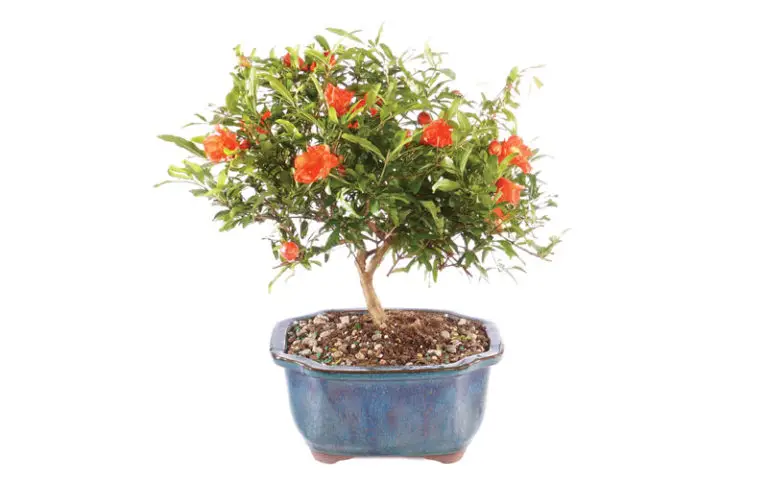
How to Care for a Pomegranate Bonsai
Pomegranate bonsai can be very durable and forgiving trees. However, they still need some specific care to flourish into stunning flowering and fruit-bearing bonsai. This guide provides more details on properly taking care of your pomegranate bonsai and ensuring that you can enjoy its beauty for years to come.
Best Soil
Your Pomegranate bonsai will be spending approximately three to four years in the same soil. This is why it is critical to ensure that your soil provides enough drainage so that the water can drain and not cause root rot.
The soil not only needs to provide drainage but also needs to be centered around decomposed granite for best results. Pomegranates thrive in soil that ranges from slightly acidic to neutral, with a pH of no more than seven. That is why it is recommended to use soil with high levels of lime and sand.
Watering
A pomegranate tree is not a very water-demanding tree, and as long as the soil is kept moist, your tree should thrive. It is essential to know that pomegranates are susceptible to root rot, so the soil mustn’t be overly wet and just moist. If you struggle to keep track of your pomegranate’s water requirements, you can use a moisture meter to help regulate your tree’s watering needs.
Pomegranate trees are very drought-hardy trees, but that does not mean that your pomegranate will not benefit from misting once a week. Therefore it is a good idea to work in a regular misting for your pomegranate into your watering schedule.
Repotting
Pomegranate trees bloom better when the roots are pot-bound. This is why you should only report your bonsai every three to four years. If you start to see roots appearing from the bottom of your bonsai pot, it is time to repot and prune the roots. Pomegranates are very resilient trees and do best when repotted late winter or early spring before the leaves start budding.
The roots of this tree are fibrous and coarse, and they hold up well to pruning. When pruning the roots of your bonsai, do not prune away more than one-third of the root ball, and try to retain at least 50% of the fine roots for the best result.
Shaping and Pruning
Pomegranates are great trees for various bonsai styles, but there are a few things you should bear in mind when thinking of a style to use. A medium to large style bonsai is better suited to the pomegranate to compensate for the size of the fruit unless you decide to go with a dwarf variant. Also, pomegranate should not be grouped and instead kept to a single tree because of the flowers and the fruit.
Pomegranates do not do well with wiring, and if you decide to wire this tree, you will have to keep a careful eye on it and remove the wiring before scarring occurs – which can happen very quickly. The best method of shaping a pomegranate is by using the clip-and-grow technique.
Location and Sunlight
Pomegranate bonsai can be grown relatively easily outdoors in areas that have a Mediterranean climate. They also do well indoors in a sunny area with good ventilation. They prefer warmer weather in the summer, and if the air temperature reaches 41 degrees Fahrenheit, they should be moved to a shadier spot or preferably indoors.
These trees love the sun and require about four to six hours of sunlight every day, although they can use less in the winter months. If kept indoors, make sure that they are in a spot that gets sun for most of the day, or use artificial light to help the bonsai thrive.
Fertilizing
Fertilizing is critical when growing bonsai as the pots are small, and nutrients get absorbed or washed away relatively quickly. Pomegranate bonsai do well with liquid bonsai fertilizers or general plant food every two weeks from spring to summer. During the winter, the pomegranate bonsai goes into a semi-dormant state requiring much less fertilizer.
If you have just repotted your bonsai, refrain from adding any additional fertilizer for three months. If you want to increase your bonsai’s blooms or growth, make sure to use a fertilizer blend with high amounts of phosphorus and potassium.
Propagation Methods
Another thing that makes pomegranate bonsai so popular is that they can easily propagate from seeds, cuttings, air layering, and layering.
To propagate from a seed, you can take the seeds straight from pomegranate fruit and remove the red aril (juicy part of the fruit we eat). Next, rinse the seeds thoroughly and rub dry with a paper towel, making sure to remove the pulpy coating. Now allow the seeds to dry for a few days. You can then place the seed in starter soil which can be placed directly in a plastic bag to keep the humidity up. Seeds can take between 30-40 days to germinate at room temperature, but if you keep the humidity high and keep the seed in a warm spot, you can cut down on the germination time.
Growing from seed can take a much longer time before you have a beautiful bonsai, as the tree needs to be planted in the ground for a couple of years for the trunk to thicken, as this will not happen in a bonsai pot. As such, some growers might prefer to work from cuttings. Hardwood cuttings should be taken in spring before the buds open, whereas semi-hardwood cuttings can be taken in summer.
Pests and Diseases
Pomegranates are relatively durable plants, but unfortunately, they are not entirely pest-free. Your pomegranate bonsai may be attacked by whiteflies, pomegranate butterfly caterpillars and aphids.
Whiteflies are especially bothersome on indoor bonsai but can be deterred by spraying your tree with water, especially underneath the leaves. Aphids can also be removed by jet water spray. You can also spray your bonsai tree with a non-toxic insecticide every few months to keep the harmful pests away.
Pomegranate bonsai are also susceptible to root rot, which can occur from overwatering. However, this issue can be avoided if you follow the proper watering techniques and ensure that your tree has sufficient draining.
Growth Patterns
Pomegranates have a medium growth rate, and this growth happens during the warmer seasons such as spring and summer. During these seasons, you will see multiple new shoots and leave growth. If you keep the new shoots, let them grow to at least 4-6” before trimming them back as the flowers will form at the end of shoots and eventually turn into large fruits.
To increase foliage, you can pinch off every first and third leaf. This will lead to a full and attractive look in your bonsai. If you want your bonsai to flower and bear fruit, wait until blooming has finished before doing any pruning.
Recommended Styles
Pomegranate bonsai are versatile and can be used in a few different styles to accentuate the tree’s natural beauty. The styles that work well with this tree are Informal Upright (Moyogi), Slanting (Shakan), Semi-Cascade (Han-Kengai), Multi Trunks (Kabudachi), Twisted Trunk (Nebikan), as these are the ways that they would appear most naturally.
Pomegranates do not do well in group plantings due to the large fruit and flowers that the tree produces.
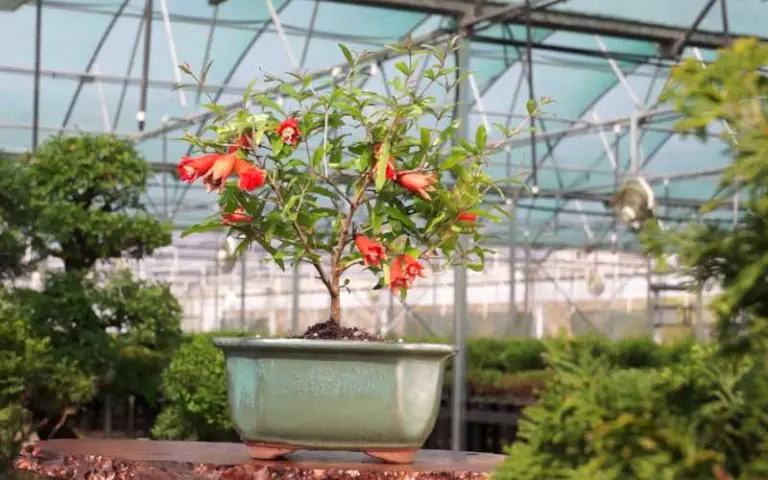
Considerations for Growing an Indoor Pomegranate Bonsai
Bringing home a new pomegranate bonsai is an exhilarating experience. These bonsai are great starter bonsai as they are easy to care for, relatively forgiving and can withstand a wide variety of climates. With some considerations and care, you can have a beautiful pomegranate bonsai.
Welcoming Home a New Pomegranate Bonsai
It is not unusual for a new bonsai to lose a few leaves when you just bring them home. After all, moving from one location to another is stressful on the tree. Once you arrive home with your bonsai, ensure that you put it in a warm place, get a lot of sunshine, and have adequate ventilation. If you do not have enough sunlight at home, consider getting a grow light to ensure your tree gets enough light.
Overwintering
The two most significant threats to your bonsai during winter are frost and overwatering. Pomegranates are deciduous and will lose their leaves in autumn. During these colder months, the tree will become dormant and will not need as much watering or fertilizer. That is why you mustn’t water the tree too often, as this can lead to root rot and frost damage.
Training Techniques
The best training technique to use with a pomegranate bonsai is the clip and grow method. Since pomegranates don’t do well with wiring, this technique uses a more gentle and natural approach that leaves you with a beautiful bonsai.
Common Issues When Caring for a Pomegranate Bonsai
While there are the usual suspects that can cause problems for your pomegranate bonsai, such as pests and root rot, there is a more common issue that doesn’t get covered as much. This is an issue with repotting. There is nothing more devastating than repotting a pomegranate bonsai and then watching as the leaves start to droop, die and fall off, all the while knowing this is your tree crying out for help.
Here are some of the causes for your bonsai reacting badly to a repotting:
● Repotting at the wrong time of the year.
● Removing too many of the roots so that they cannot absorb enough nutrients, water and air from the ground.
● Not removing enough roots and leaving the roots to starve themselves.
● Stress to the plant.
What can you do to fix this issue:
● Only repot your bonsai at the end of winter or early spring. Young bonsai can be repotted every one to two years, while adults should be replanted every three to four years.
● Remember that repotting is stressful to the plant, so it is natural to see some drooping leaves. Ensure that your plant is kept in a safe spot with high humidity, warmth, and no wind.
● Do not fertilize your bonsai for three months after repotting.
Interesting Facts About Pomegranate Bonsai
Let’s look at some of the most exciting facts about pomegranate bonsai.
● The name Punica, from Punica Granata, is from the ancient Phoenicians who were active in cultivating pomegranates for religious purposes.
● Pomegranate bonsai trees flower and produce delicious, edible fruits.
● The pomegranate fruit is rich in antioxidants.
● In some countries, pomegranate seeds are used as spices and for medical purposes.
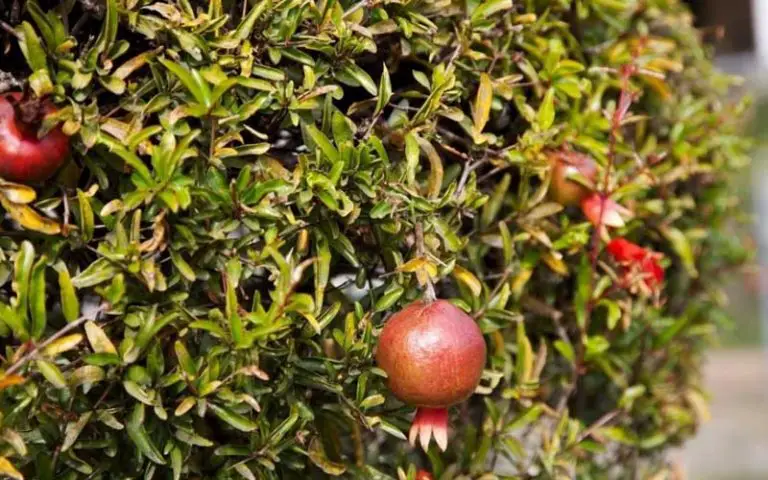
FAQ About Pomegranate Bonsai
Now, to answer any lingering questions that you may still have, we’ve set up this quick FAQ.
Yes, a pomegranate bonsai thrives in warmer temperatures and between four to six hours of direct sunlight a day. The only time that your pomegranate can do with less sunshine is during the winter months.
Pomegranate bonsai are very susceptible to root rot, caused when the roots are submerged in water for an extended period. As such, you mustn’t overwater your bonsai. A good guide is to make sure that the soil is moist at all times but not wet.
Pomegranate bonsai needs about two to three years to start producing fruit consistently. The fruits can take between five to seven months to mature and need to ripen on the tree.
Yes, pomegranate bonsai can be grown successfully indoors when placed in a warm place with sufficient sunlight. However, these bonsai also thrive in greenhouses and even outdoors if the climate allows.
A pomegranate bonsai can easily grow older than 200 years if the proper care is taken.
Yes, you can! The fruit from your pomegranate bonsai is edible, and it will taste just as good as pomegranates bought at the store, if not better.


